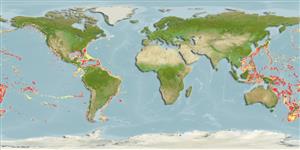Common names from other countries
>
Gadiformes (Cods) >
Macrouridae (Grenadiers or rattails)
Etymology: Hymenocephalus: Named for its transparent membrane-like head covering (‘‘hymen head’’) and fragile nature of head bones (Ref. 100825).
More on author: Gilbert.
Environment: milieu / climate zone / depth range / distribution range
Οικολογία
Θαλασσινό(ά) βενθοπελαγικό; εύρος βάθους 340 - 1348 m (Ref. 58302). Deep-water
Widespread but patchy and discontinuous. Atlantic: Caribbean and continental slope of northern South America. Pacific: off subtropical western and eastern Australia, several islands in the southern Pacific (New Caledonia, Vanuatu, Wallis & Futuna, Marquesas Islands), and off Hawaii. Not recorded from eastern Atlantic nor Indian Ocean.
Μέγεθος / Βάρος / Age
Maturity: Lm ? range ? - ? cm
Max length : 20.0 cm TL αρσενικό/απροσδιόριστο; (Ref. 37108)
This species is distinguished by the following characters: a black-colored large-headed fish, with head size 21-25% TL; pelvic fin rays 13-14; pectoral fin rays 13-16; projecting snout, 20-24% HL; head bones are papery thin and often distorted; no barbel; small orbit diameter, 20-24% HL; interorbital width 60-70% HW; infraorbital width 20-25% HL; postorbital-preopercular interspace 10-14% HL; preopercular supporter is very small and forked; gill rakers 21-25; ventral striae reaching to about ? from pelvic fin bases to periproct; small otolith with rounded outline, no predorsal lobe developed; colliculi separated; otholith length to height (OL:OH), 1.0-1.2; total colliculum length to pseudocolliculum length (TCL:PCL) is 2.2-2.8 (Ref. 98298).
Found on the continental slope (Ref. 75154). Benthopelagic (Ref. 58302).
Life cycle and mating behavior
Maturities | Αναπαραγωγή | Spawnings | Egg(s) | Fecundities | Προνύμφες
Cohen, D.M., A.W. Ebeling, T. Iwamoto, S.B. McDowell, N.B. Marshall, D.E. Rosen, P. Sonoda, W.H. Weed III and L.P. Woods, 1973. Fishes of the western North Atlantic. Part six. New Haven, Sears Found. Mar. Res., Yale Univ. (Ref. 37108)
IUCN Red List Status (Ref. 130435)
CITES (Ref. 128078)
Not Evaluated
Threat to humans
Harmless
Human uses
Εργαλεία
Special reports
Download XML
Διαδικτυακές πηγές
Estimates based on models
Preferred temperature (Ref.
115969): 5.1 - 10.2, mean 7.1 (based on 622 cells).
Phylogenetic diversity index (Ref.
82804): PD
50 = 0.5000 [Uniqueness, from 0.5 = low to 2.0 = high].
Bayesian length-weight: a=0.00219 (0.00111 - 0.00431), b=3.20 (3.03 - 3.37), in cm Total Length, based on LWR estimates for this (Sub)family-body shape (Ref.
93245).
Τροφικό Επίπεδο (Ref.
69278): 3.4 ±0.4 se; based on size and trophs of closest relatives
Ελαστικότητα (Ref.
120179): Μεσαίο(α), ελάχιστος χρόνος για διπλασιασμό πληθυσμού 1,4 - 4,4 έτη (Preliminary K or Fecundity.).
Fishing Vulnerability (Ref.
59153): Low vulnerability (10 of 100).
